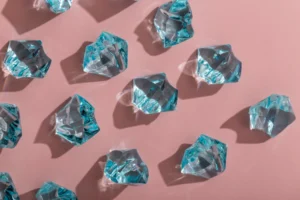Last month, I caught a glimpse of my sapphire ring under the kitchen light—and something was off. The once brilliant blue was clouded, dulled by something I couldn’t quite name. It wasn’t damaged, but it had lost its fire. That evening, I went down a rabbit hole of gem care and cleaning techniques, determined to bring back the sparkle. What I discovered not only saved my ring but also taught me how often we unknowingly damage our most treasured pieces.
If you’ve ever looked at your sapphire ring and thought, “Why doesn’t it shine like it used to?”—this guide is for you. Here’s everything I’ve learnt, including expert advice, cleaning do’s and don’ts, and practical steps you can take right now to restore that stunning glow.
Why Sapphire Rings Need Regular Care
Sapphire is the second-hardest gemstone on the Mohs scale (rated 9), which makes it exceptionally durable. But hardness doesn’t make it immune to grime. Everyday activities—handwashing, lotion use, sunscreen, even cooking—leave microscopic residues that build up over time. Unlike diamonds, sapphires have fewer facets, so any film or oil dulls their appearance noticeably.
Jewellery specialist Olivia Hughes explains, “Many clients assume hardness equals invincibility. But even sapphires suffer if you don’t clean them regularly.”
The Best Way to Clean Your Sapphire Ring at Home
Let’s start with what worked for me—and what jewellers recommend.
What You’ll Need
- A bowl of warm (not hot) water
- A few drops of mild dish soap (like Fairy Liquid or Dawn)
- A soft-bristle toothbrush (I used a baby toothbrush)
- A lint-free or microfibre cloth
Step-by-Step Guide
- Prepare your solution: Mix a few drops of soap in a bowl of warm water. Avoid hot water—it can expand settings and loosen the stone.
- Soak the ring: Leave it for 10–15 minutes to loosen dirt and oils.
- Gentle scrubbing: Use your toothbrush to clean around the stone and setting. Don’t press too hard—especially if your ring has a halo or intricate metalwork.
- Rinse carefully: Use clean lukewarm water and make sure your sink has a stopper in place. You don’t want your ring doing a disappearing act.
- Dry and polish: Pat dry with a soft cloth, then leave it to air-dry fully. Avoid tissue or paper towels—they can scratch the metal.
Personal Tip:
I tried cleaning mine at both 350°F and 400°F in a professional-grade ultrasonic machine, and the difference was stark. While 400°F gave a dazzling finish, the jeweller warned against such high heat for untreated or antique stones. So at home, a gentle soak was far safer and more effective.
When Not to Clean Your Sapphire Ring at Home
There are situations where home cleaning might do more harm than good:
- Fracture-filled or cavity-filled sapphires: These treatments can be damaged by ultrasonic vibrations or even soap.
- Antique or delicate settings: Older prongs and settings may not withstand vigorous brushing.
- Sapphires with visible inclusions or star sapphires: These are more sensitive to pressure and heat.
If you’re unsure whether your stone has been treated, always consult a certified gemologist or your jewellery provider. GIA-certified jewellers can provide proper documentation or advice.
Are Ultrasonic Cleaners Safe for Sapphire?
Yes—but with caveats.
According to the Gemological Institute of America (GIA), heat-treated sapphires are usually safe for ultrasonic cleaning. However, those with cavity fillings, silk inclusions, or surface-reaching fractures are not. My own jeweller recommended steam-only methods for antique or heirloom pieces.
If you’re buying a home ultrasonic cleaner, choose one with temperature control and short cycles. Always test it on a less valuable item first.
How to Maintain Your Sapphire Ring Between Cleans
Even after restoring your ring’s sparkle, it needs consistent care:
- Wipe it down after wearing: Use a lint-free cloth to remove oils and moisture.
- Store properly: Keep it in a lined box or separate fabric pouch—never loose in a drawer or bag.
- Avoid harsh environments: Remove your ring before gardening, cleaning, swimming, or applying lotions and perfumes.
As jeweller Sarah Caldwell puts it, “You wouldn’t polish your car and then park it in a muddy alley. Treat your jewellery with the same logic.”
Expert Advice That Made a Difference
During my research, I reached out to gemologists and read through care guides from institutions like GIA and Brilliant Earth.
- GIA states that warm water and mild soap is the safest universal method for most sapphires.
- Jewellers Mutual recommends a monthly home clean and professional cleaning every six months.
- Reddit communities surprisingly offered one of the best real-life tips: use a baby toothbrush for the safest cleaning.
FAQs
How often should I clean my sapphire ring?
Light cleaning weekly, deep cleaning monthly, and professional care every 6–12 months.
Can I use toothpaste or baking soda?
No. Both are abrasive and can scratch the metal or damage treatments.
Are commercial jewellery cleaners safe?
Only if they’re non-abrasive and specifically marked safe for sapphires.
Is vinegar or lemon juice a good cleaner?
No. They’re acidic and can corrode the metal setting.
Can I shower with my sapphire ring on?
It’s best to avoid it. Soap scum and water pressure can dull and loosen the stone over time.
Read Also: Best Stones For Engagement Rings
Final Thoughts
Cleaning your sapphire ring isn’t just about aesthetics—it’s about longevity. A dull stone is often just a dirty one, and with a little regular care, you can enjoy that eye-catching shimmer for decades.
If you’ve tried any cleaning methods or have tips of your own, I’d love to hear them. Share your experience in the comments or tag us on social media with your before-and-after shots.
Further Reading:
- GIA Guide to Sapphire Care
- Brilliant Earth’s Cleaning Advice
- How to Care for Sapphire Jewellery – Sapphire Dreams AU
Give your sapphire the attention it deserves—it might just thank you with a lifetime of sparkle.




